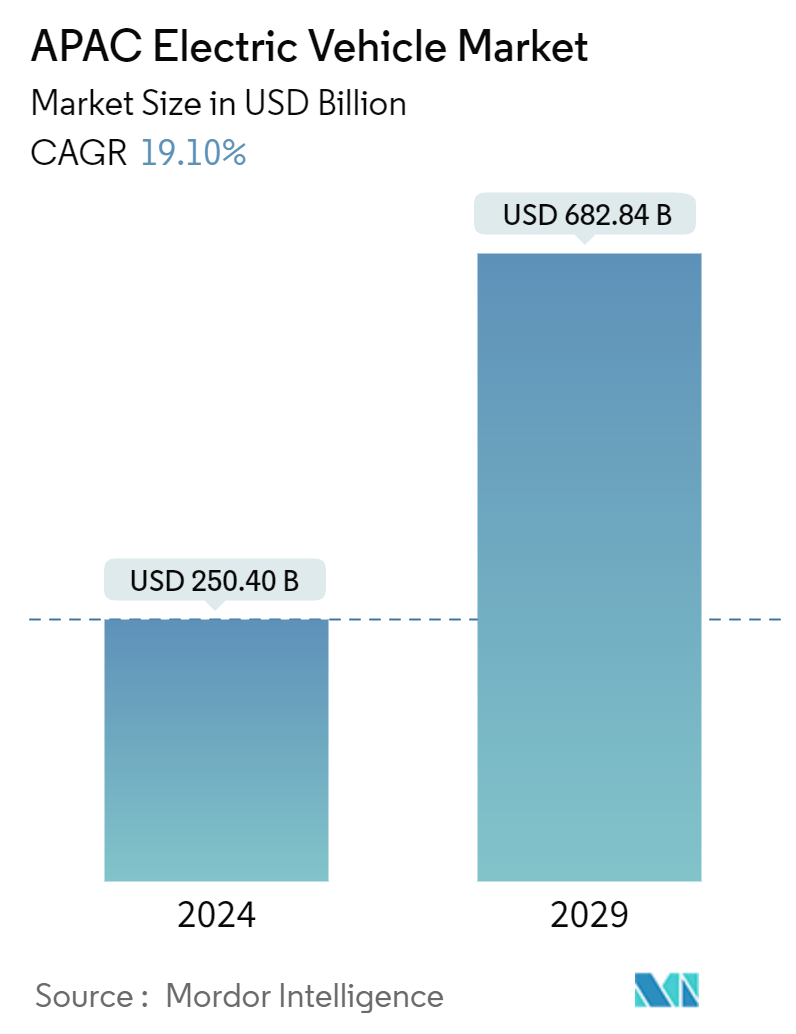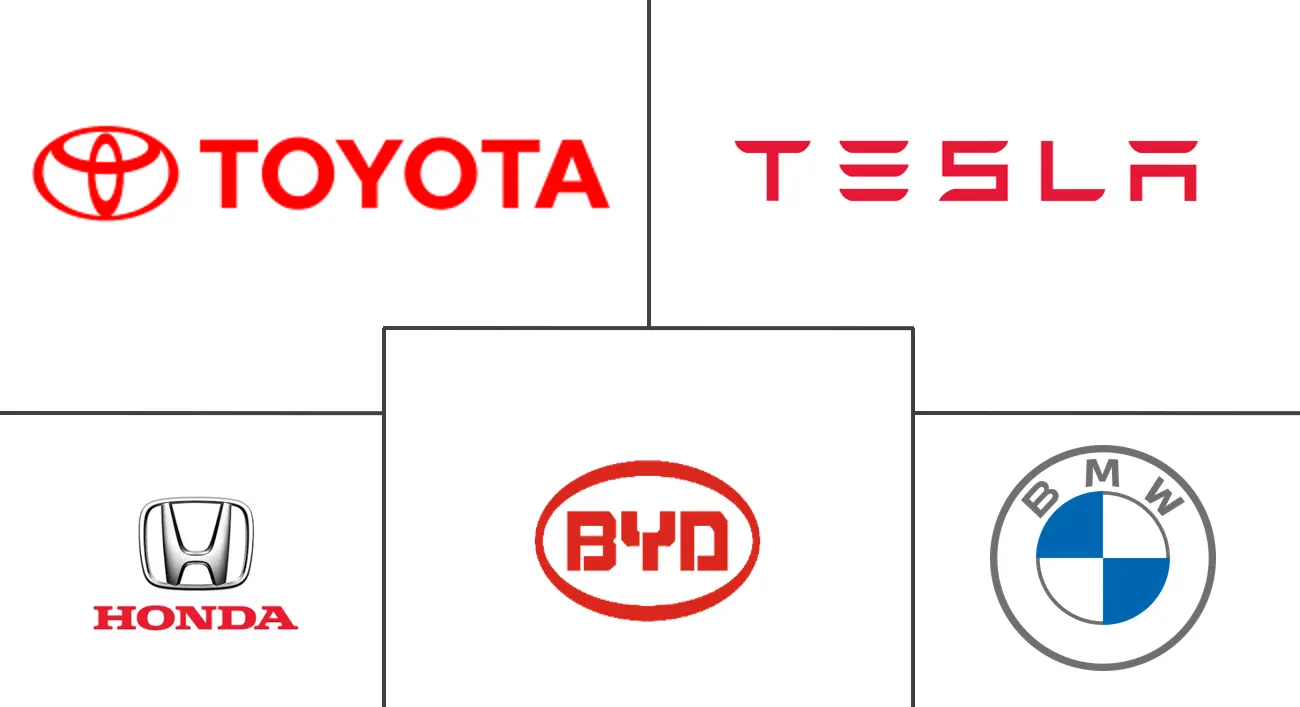Market Size of APAC Electric Vehicle Industry

| Study Period | 2019 - 2029 |
| Base Year For Estimation | 2023 |
| Market Size (2024) | USD 250.40 Billion |
| Market Size (2029) | USD 682.84 Billion |
| CAGR (2024 - 2029) | 19.10 % |
| Market Concentration | Low |
Major Players
*Disclaimer: Major Players sorted in no particular order |
APAC Electric Vehicle Market Analysis
The APAC Electric Vehicle Market size is estimated at USD 250.40 billion in 2024, and is expected to reach USD 682.84 billion by 2029, growing at a CAGR of 19.10% during the forecast period (2024-2029).
The Asia-Pacific electric vehicle market has grown steadily in recent years. Over the long term, the growing demand for electric vehicles, increasing charging infrastructure, and stringent policies by the government to promote electric charging infrastructure to achieve the net zero emission carbon goals may drive market growth. These trends are expected to propel the Asia-Pacific electric vehicle market forward throughout the forecast period.
According to the Automobile Inspection & Registration Information Association (Japan), the use of electric passenger vehicles in Japan increased from 138.33 thousand units in 2022 to 162.39 thousand in 2023, contributing to an exponential rise in EV sales.
Notably, electric cars are gradually becoming more competitive in some countries on a total cost of ownership basis. Several governments provided or extended fiscal incentives that buffered electric car purchases from the downturn in car markets.
With the growing demand for electric vehicles, companies focus on technological advances in new products and expanding production capacity.
For instance, India, one of the biggest consumers of electric vehicles, is expected to witness the launch of new models such as the Tata Harrier EV, Maruti Suzuki eVX, and various other electric vehicle cars in 2024.
Considering the growth in EV sales, companies are making huge investments in R&D activities and product launches, with the initiative to promote EV charging infrastructure in Asia-Pacific. For example:
- In November 2023, XCharge Group, an electric vehicle (EV) charging solution provider, announced the introduction of the 210 kW Battery-Integrated DC Charger, Net Zero Series (NZS), at the Smart Energy Week in Osaka, Japan, in partnership with BYD to cater to the Japanese market.
In addition, the market is expected to garner more attention during the forecast period, driven by the country's electrification plans for urban mobility transport, which may contribute to market demand for electric vehicles.
APAC Electric Vehicle Industry Segmentation
An electric vehicle (EV) operates on an electric motor instead of an internal combustion engine that generates power by burning a mix of fuel and gases. Due to rising pollution, global warming, and depleting natural resources, EVs are becoming a possible replacement option for current-generation automobiles across the region.
The Asia-Pacific electric vehicle market is segmented by propulsion type, vehicle type, charging type, and country.
By propulsion type, the market is segmented into battery electric vehicles, hybrid electric vehicles, plug-in hybrid electric vehicles, and fuel cell electric vehicles. By vehicle type, the market is segmented into passenger cars and commercial vehicles. By charging type, the market is segmented as normal charging and fast charging. By country, the market is segmented into China, India, Japan, South Korea, and Rest of Asia-Pacific.
The report offers market size and forecasts in value (USD) and volume (units) for all the above segments.
| Propulsion Type | |
| Battery Electric Vehicles | |
| Hybrid Electric Vehicles | |
| Fuel Cell Electric Vehicles | |
| Plug-in Hybrid Electric Vehicles |
| Vehicle Type | |
| Passenger Cars | |
| Commercial Vehicles |
| Charging Type | |
| Normal Charging | |
| Fast Charging |
| Country | |
| China | |
| India | |
| Japan | |
| South Korea | |
| Rest of Asia-Pacific |
APAC Electric Vehicle Market Size Summary
The Asia-Pacific electric vehicle market is experiencing significant growth, driven by increasing demand for electric vehicles, expanded charging infrastructure, and supportive government policies aimed at achieving net-zero emissions. The market is characterized by a steady rise in electric vehicle adoption, with countries like China and India leading the charge. In China, the largest electric vehicle market globally, rapid growth in production and sales is supported by extensive charging networks and substantial investments in infrastructure. Similarly, India is witnessing a surge in electric vehicle models and production capacity, with companies focusing on technological advancements and new product launches to meet the growing consumer demand.
The market landscape is highly competitive, with major players such as Toyota, Tesla, Nissan, BYD, and Honda actively engaging in strategies like product launches, collaborations, and investments to maintain their market positions. The Asia-Pacific region is also seeing increased collaboration among countries and industry associations to promote electric vehicle adoption and infrastructure development. As governments continue to offer fiscal incentives and implement policies to phase out internal combustion engine vehicles, the electric vehicle market is poised for substantial growth, with companies making significant investments in research, development, and production facilities to capitalize on the burgeoning demand.
APAC Electric Vehicle Market Size - Table of Contents
-
1. MARKET DYNAMICS
-
1.1 Market Drivers
-
1.1.1 Government Initiatives to Promote EV Sales
-
-
1.2 Market Restraints
-
1.2.1 High Initial Investment for Installing EV Charging Infrastructure
-
-
1.3 Porter's Five Forces Analysis
-
1.3.1 Threat of New Entrants
-
1.3.2 Bargaining Power of Buyers/Consumers
-
1.3.3 Bargaining Power of Suppliers
-
1.3.4 Threat of Substitute Products
-
1.3.5 Intensity of Competitive Rivalry
-
-
-
2. MARKET SEGMENTATION (Market Size in USD)
-
2.1 Propulsion Type
-
2.1.1 Battery Electric Vehicles
-
2.1.2 Hybrid Electric Vehicles
-
2.1.3 Fuel Cell Electric Vehicles
-
2.1.4 Plug-in Hybrid Electric Vehicles
-
-
2.2 Vehicle Type
-
2.2.1 Passenger Cars
-
2.2.2 Commercial Vehicles
-
-
2.3 Charging Type
-
2.3.1 Normal Charging
-
2.3.2 Fast Charging
-
-
2.4 Country
-
2.4.1 China
-
2.4.2 India
-
2.4.3 Japan
-
2.4.4 South Korea
-
2.4.5 Rest of Asia-Pacific
-
-
APAC Electric Vehicle Market Size FAQs
How big is the APAC Electric Vehicle Market?
The APAC Electric Vehicle Market size is expected to reach USD 250.40 billion in 2024 and grow at a CAGR of 19.10% to reach USD 682.84 billion by 2029.
What is the current APAC Electric Vehicle Market size?
In 2024, the APAC Electric Vehicle Market size is expected to reach USD 250.40 billion.

